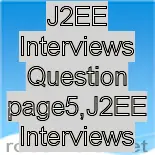J2EE Interviews Question page5
- What is EAR file ?
Enterprise Archive file. A JAR archive that contains a J2EE application.
-
What is ebXML ?
Electronic Business XML. A group of specifications designed to enable enterprises to conduct business through the exchange of XML-based messages. It is sponsored by OASIS and the United Nations Centre for the Facilitation of Procedures and Practices in Administration, Commerce and Transport (U.N./CEFACT).
-
What is EJB ?
Enterprise JavaBeans.
-
What is EJB container ?
A container that implements the EJB component contract of the J2EE architecture. This contract specifies a runtime environment for enterprise beans that includes security, concurrency, life-cycle management, transactions, deployment, naming, and other services. An EJB container is provided by an EJB or J2EE server.
-
What is EJB container provider ?
A vendor that supplies an EJB container.
-
What is EJB context ?
A vendor that supplies an EJB container. An object that allows an enterprise bean to invoke services provided by the container and to obtain the information about the caller of a client-invoked method.
-
What is EJB Home object ?
An object that provides the life-cycle operations (create, remove, find) for an enterprise bean. The class for the EJB Home object is generated by the container's deployment tools. The EJB Home object implements the enterprise bean's Home interface. The client references an EJB Home object to perform life-cycle operations on an EJB object. The client uses JNDI to locate an EJB Home object.
-
What is EJB JAR file ?
A JAR archive that contains an EJB module.
-
What is EJB module ?
A deployable unit that consists of one or more enterprise beans and an EJB deployment descriptor.
-
What is EJB object ?
An object whose class implements the enterprise bean's remote interface. A client never references an enterprise bean instance directly; a client always references an EJB object. The class of an EJB object is generated by a container's deployment tools.
-
What is EJB server ?
Software that provides services to an EJB container. For example, an EJB container typically relies on a transaction manager that is part of the EJB server to perform the two-phase commit across all the participating resource managers. The J2EE architecture assumes that an EJB container is hosted by an EJB server from the same vendor, so it does not specify the contract between these two entities. An EJB server can host one or more EJB containers.
-
What is EJB server provider ?
A vendor that supplies an EJB server.
-
What is element ?
A unit of XML data, delimited by tags. An XML element can enclose other elements.
-
What is empty tag ?
A tag that does not enclose any content.
-
What is enterprise bean ?
A J2EE component that implements a business task or business entity and is hosted by an EJB container; either an entity bean, a session bean, or a message-driven bean.
-
What is enterprise bean provider ?
An application developer who produces enterprise bean classes, remote and Interview Questions - Home interfaces, and deployment descriptor files, and packages them in an EJB JAR file.
-
What is enterprise information system ?
The applications that constitute an enterprise's existing system for handling companywide information. These applications provide an information infrastructure for an enterprise. An enterprise information system offers a well-defined set of services to its clients. These services are exposed to clients as local or remote interfaces or both. Examples of enterprise information systems include enterprise resource planning systems, mainframe transaction processing systems, and legacy database systems.
-
What is enterprise information system resource ?
An entity that provides enterprise information system-specific functionality to its clients. Examples are a record or set of records in a database system, a business object in an enterprise resource planning system, and a transaction program in a transaction processing system.



